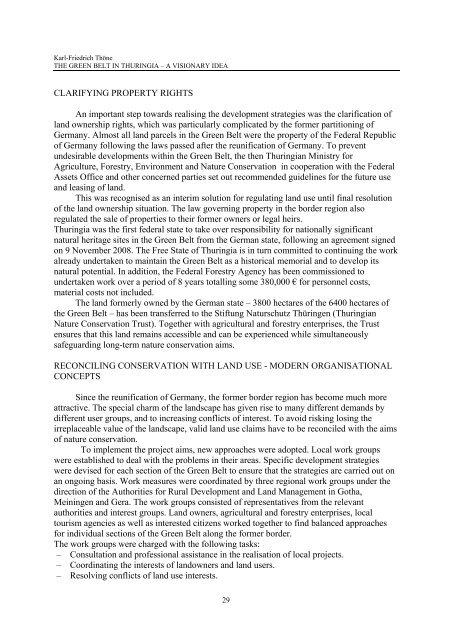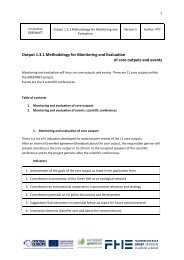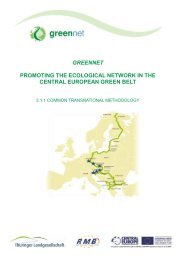The Green Belt as a European Ecological Network strengths and gaps
The Green Belt as a European Ecological Network strengths and gaps
The Green Belt as a European Ecological Network strengths and gaps
Create successful ePaper yourself
Turn your PDF publications into a flip-book with our unique Google optimized e-Paper software.
Karl-Friedrich Thöne<br />
THE GREEN BELT IN THURINGIA – A VISIONARY IDEA<br />
CLARIFYING PROPERTY RIGHTS<br />
An important step towards realising the development strategies w<strong>as</strong> the clarification of<br />
l<strong>and</strong> ownership rights, which w<strong>as</strong> particularly complicated by the former partitioning of<br />
Germany. Almost all l<strong>and</strong> parcels in the <strong>Green</strong> <strong>Belt</strong> were the property of the Federal Republic<br />
of Germany following the laws p<strong>as</strong>sed after the reunification of Germany. To prevent<br />
undesirable developments within the <strong>Green</strong> <strong>Belt</strong>, the then Thuringian Ministry for<br />
Agriculture, Forestry, Environment <strong>and</strong> Nature Conservation in cooperation with the Federal<br />
Assets Office <strong>and</strong> other concerned parties set out recommended guidelines for the future use<br />
<strong>and</strong> le<strong>as</strong>ing of l<strong>and</strong>.<br />
This w<strong>as</strong> recognised <strong>as</strong> an interim solution for regulating l<strong>and</strong> use until final resolution<br />
of the l<strong>and</strong> ownership situation. <strong>The</strong> law governing property in the border region also<br />
regulated the sale of properties to their former owners or legal heirs.<br />
Thuringia w<strong>as</strong> the first federal state to take over responsibility for nationally significant<br />
natural heritage sites in the <strong>Green</strong> <strong>Belt</strong> from the German state, following an agreement signed<br />
on 9 November 2008. <strong>The</strong> Free State of Thuringia is in turn committed to continuing the work<br />
already undertaken to maintain the <strong>Green</strong> <strong>Belt</strong> <strong>as</strong> a historical memorial <strong>and</strong> to develop its<br />
natural potential. In addition, the Federal Forestry Agency h<strong>as</strong> been commissioned to<br />
undertaken work over a period of 8 years totalling some 380,000 € for personnel costs,<br />
material costs not included.<br />
<strong>The</strong> l<strong>and</strong> formerly owned by the German state – 3800 hectares of the 6400 hectares of<br />
the <strong>Green</strong> <strong>Belt</strong> – h<strong>as</strong> been transferred to the Stiftung Naturschutz Thüringen (Thuringian<br />
Nature Conservation Trust). Together with agricultural <strong>and</strong> forestry enterprises, the Trust<br />
ensures that this l<strong>and</strong> remains accessible <strong>and</strong> can be experienced while simultaneously<br />
safeguarding long-term nature conservation aims.<br />
RECONCILING CONSERVATION WITH LAND USE - MODERN ORGANISATIONAL<br />
CONCEPTS<br />
Since the reunification of Germany, the former border region h<strong>as</strong> become much more<br />
attractive. <strong>The</strong> special charm of the l<strong>and</strong>scape h<strong>as</strong> given rise to many different dem<strong>and</strong>s by<br />
different user groups, <strong>and</strong> to incre<strong>as</strong>ing conflicts of interest. To avoid risking losing the<br />
irreplaceable value of the l<strong>and</strong>scape, valid l<strong>and</strong> use claims have to be reconciled with the aims<br />
of nature conservation.<br />
To implement the project aims, new approaches were adopted. Local work groups<br />
were established to deal with the problems in their are<strong>as</strong>. Specific development strategies<br />
were devised for each section of the <strong>Green</strong> <strong>Belt</strong> to ensure that the strategies are carried out on<br />
an ongoing b<strong>as</strong>is. Work me<strong>as</strong>ures were coordinated by three regional work groups under the<br />
direction of the Authorities for Rural Development <strong>and</strong> L<strong>and</strong> Management in Gotha,<br />
Meiningen <strong>and</strong> Gera. <strong>The</strong> work groups consisted of representatives from the relevant<br />
authorities <strong>and</strong> interest groups. L<strong>and</strong> owners, agricultural <strong>and</strong> forestry enterprises, local<br />
tourism agencies <strong>as</strong> well <strong>as</strong> interested citizens worked together to find balanced approaches<br />
for individual sections of the <strong>Green</strong> <strong>Belt</strong> along the former border.<br />
<strong>The</strong> work groups were charged with the following t<strong>as</strong>ks:<br />
– Consultation <strong>and</strong> professional <strong>as</strong>sistance in the realisation of local projects.<br />
– Coordinating the interests of l<strong>and</strong>owners <strong>and</strong> l<strong>and</strong> users.<br />
– Resolving conflicts of l<strong>and</strong> use interests.<br />
29




